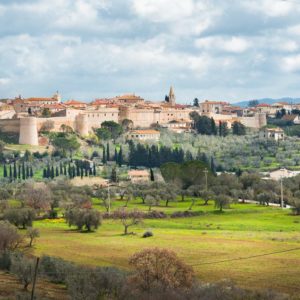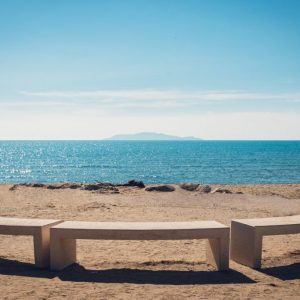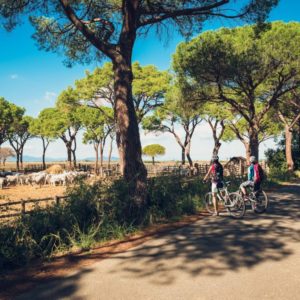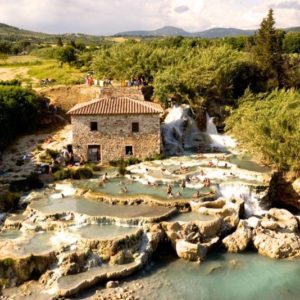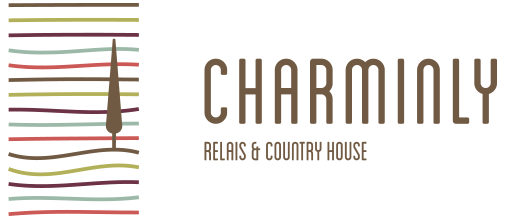Città del Tufo
In the heart of the Tuscan Maremma, the Tufo Area is the ancient territory inhabited by the Etruscans and Romans and today guardian of precious relics of their passage and breathtaking villages.
The Città del Tufo are the ancient villages first inhabited in ancient times by the Etruscans and later by the Romans, and today their villages speak of centuries of history, Pitigliano, Sovana and Sorano host an invaluable archaeological heritage, the great Archaeological Città del Tufo Outdoor Park, where the Vie Cave, the imposing streets dug by the Etruscans in the tufa rock, are located, large walls up to 20 metres high that protect narrow paths, and the “the Cities of the Dead” Necropolis of the Etruscans.
Pitigliano
One of the most beautiful villages in Italy and one of the most interesting centres of the Tufo Area. Pitigliano is the most famous town in the area, perched on a tufa spur, unique and appearing almost suspended in the void! Arriving at night is an experience not to be missed, the towns seems to be supported by a mysterious force … Pitigliano is also known as “Little Jerusalem”, home to a Jewish Ghetto with a splendid Synagogue.
The origins of this town are very ancient: legend has it that it was founded by two young Romans, Petilio and Celiano, after their escape from Rome following the theft of the Golden Crown of Jupiter. The name Pitigliano derives from the names of the two young men. Beyond the legend, Pitigliano has Etruscan origins, the territory was inhabited in XII-XI century BC. There was a village in present-day Pitigliano, as evidenced by findings made in the oldest part of the town. In Roman times, the town, which supposedly takes its name from that of the Gens Petilia, a noble Roman family, was placed under the control of nearby Sovana. The first real evidence about the existence of a city with the name of Pitigliano dates back to 1061, when the town was mentioned in a bull by Pope Nicholas III. In the medieval period, Pitigliano was ruled by the Aldobrandeschi who remained in power until 1313, when they were replaced by the Orsini, following the marriage between Anastasia di Montfort, daughter of Margherita Aldobrandeschi and Count Gentile Orsini. The Orsini rule lasted until 1604, when it passed to the Medici of Florence. The Habsburgs-Lorraine followed in 1737.
Pitigliano is incredibly rich in historic buildings and monuments that tell the story of its long past. Among its alleys there are ancient buildings, precious evidence of the history of the Città del Tufo territory.
The Cathedral of Saints Peter and Paul is the main sacred building in Pitigliano, dating back to 1276, but its present appearance derives from the restoration work carried out by Count Niccolò III Orsini. Inside the church are splendid works, particularly interesting a wooden baptismal font from the XVIII century, a painting of San Paolo della Croce, dating back to 1800. The frescoes of the vault depict the Four Evangelists and the Glorious Cross, while two paintings depict the predestination of the young Ildebrando and Henry IV in Canossa, from the end of the 1800s and by the Mannerian painter Pietro Aldi. There’s also a 1609 painting of the Madonna of the Rosary with Saint Catherine of Siena, Saint Pio V and Saint Domenico from the Sienese school and attributed to Francesco Vannini.
The Church of San Rocco is the oldest building in Pitigliano, dating back to 1100 and restored at the end of the fifteenth century for Count Niccolò III Orsini. Inside the church are, in addition to the numerous frescoes, the coats of arms of the noble families of Pitigliano.
Palazzo Orsini rises in the main square of Pitigliano and is one of the most important buildings in the town. It was built as a convent at the end of 1100 and became the property of the Aldobrandeschi family, who made it its official residence at the end of the 13th century. Today the palace houses two museums, the Archaeological Museum and the Diocesan Museum of Sacred Art.
The Medici Aqueduct is undoubtedly the most imposing construction in Pitigliano. Visible from afar, its structure is unmistakable, with its 15 arches. The complex was built between the 17th and 18th centuries to supply water to the city.
The Jewish Ghetto is probably the most fascinating quarter of Pitigliano, since the Tuscan town in fact hosted, from the sixteenth century, a large Jewish community fleeing the Papal States following the issuing of the papal bulls of 1555 and 1569, which limited their freedom. The new community was greeted with great enthusiasm by the locals and soon a Jewish quarter was built with an unleavened bread bakery, a kosher butchery, ritual baths, a wine cellar and a Synagogue.
Sovana
Sovana is officially one of the “Most Beautiful Villages in Italy” and one of the most important villages in the Tufa Area. The village has very ancient origins and is today a precious treasure chest of monuments and ancient buildings.
The territory of Sovana has welcomed human settlements since 1000 BC, when there were small villages of farmers and shepherds along the banks of the Fiora River. Soon these settlements joined and gave life to the ancient Suana, which, in Etruscan times, traded with the other Etruscan cities of Statonia, Chiusi, Saturnia and Cetona and became an important centre under the control of powerful Vulci. Under the Roman Empire, Sovana was raised to the role of Municipium. In the V century, Sovana was chosen as a bishopric. Starting from the IX century it became a possession of the Aldobrandeschi who reigned over the territory until 1293, when the last exponent of the Aldobrandeschi, Anastasia, married the count Romano Orsini. There was a brief period of Sienese domination, but soon the Orsini managed to restore power, until the village’s definitive fall at the hands of the Medici of Florence. The city then passed to the Lorraines.
Sovana develops along the only road that crosses the village and has its centre in the splendid Piazza del Pretorio, where all the main historic buildings rise.
The Palazzo Pretorio was built in Romanesque style in the 12th century and was restored under the Republic of Siena around 1410. On the facade of the building, you can see the crests of the captains and commissioners who governed the city.
The Palazzo dell’Archivio dates back to the XII-XIII century. It is characterized by the bell tower and the clock that stands out in the facade. The building performed public functions.
The Loggia del Capitano is a characteristic building with a portico structure. On the façade you can see the great coat of arms of Cosimo I Medici.
The Church of Santa Maria Maggiore was built between the twelfth and thirteenth centuries. The exterior is simple and essential, the interior is divided into three naves, noting the octagonal pillars, the ceiling trusses in Romanesque style and the beautiful pre-Romanesque Ciborio, dating back to the eighth century, unique in Tuscany.
Outside the square, at the end of the village, is the Cathedral of Saints Peter and Paul. The beautiful cathedral dates back to the 11th century and was built in Romanesque style.
The Rocca Aldobrandesca is located on the opposite side of the Duomo and is one of the oldest buildings in Sovana. It was built in the 11th century as part of the city walls. It was restored several times, first by the Sienese and then by the Medici, but was abandoned in the 1600s and today is an impressive ruin.
Sorano
A beautiful village in the area of Tufo, built imposingly on a boulder of tufa rock, overlooking the valley of the river Lente, Sorano is a splendid example of medieval Maremman art. The inhabited area is one of the most unique in Tuscany, with a grandiose boundary wall that surrounds the oldest part.
In Etruscan times, Sorano had a small village under the control of the nearby, and more powerful, city of Sovana. The first records of a city date back to the 3rd century BC when the Romans conquered the Etruscan territories. The history of Sorano begins in 862, the year of the Aldobrandeschi Counts beginning. From 862 to 1313, Sorano remained under the rule of the Aldobrandeschi family, following the vicissitudes of the county. With the arrival of the Orsini, Sorano experienced a period of great growth, taking on an important role in the struggles against the Sienese. Nevertheless the town was annexed, like the whole Orsini county, to the Republic of Siena in 1417. At the fall of the Sienese, in 1555, Sorano returned for a short period to the Orsini, only to be conquered by the Florentines under the rule of the Medici who remained in power until 1737, when the county passed to the Lorraines.
The Palazzo Comitale was the first residence of the Orsini family in Sorano. With its clear Renaissance forms, the palace houses a portal where there is a dedication to Count Ludovico Orsini. The portal leads to the inner courtyard, where you can admire the arches and a loggia.
The Orsini Fortress was built by the Aldobrandeschi as their official residence in Sorano and was then restored by the Orsini who made it their final home in the Tuscan city. The fortress stands in a dominant position over the village of Sorano, and today houses the Museum of the Middle Ages and Renaissance.
The Masso Leopoldino, on the opposite side of the Orsini Fortress, was erected for military purposes at the end of the 1700s.
The Church of San Niccolò was built between 1290 and 1300 at the behest of Countess Margherita Aldobrandeschi.
Sovana / Città del Tufo
Sorano / Città del Tufo
Pitigliano / Città del Tufo

